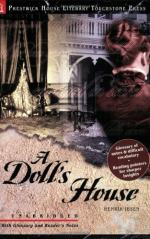|
This section contains 312 words (approx. 1 page at 400 words per page) |

|
A Doll's House Summary & Study Guide Description
A Doll's House Summary & Study Guide includes comprehensive information and analysis to help you understand the book. This study guide contains the following sections:
This detailed literature summary also contains Bibliography and a Free Quiz on A Doll's House by Henrik Ibsen.
A Doll's House was published on December 4, 1879, and first performed in Copenhagen on December 21, 1879. The work was considered a publishing event and the play's initial printing of 8,000 copies quickly sold out. The play was so controversial that Ibsen was forced to write a second ending that he called "a barbaric outrage" to be used only when necessary. The controversy centered around Nora's decision to abandon her children, and in the second ending she decides that the children need her more than she needs her freedom. Ibsen believed that women were best suited to be mothers and wives, but at the same time, he had an eye for injustice and Helmer's demeaning treatment of Nora was a common problem. Although he would later be embraced by feminists, Ibsen was no champion of women's rights; he only dealt with the problem of women's rights as a facet of the realism within his play. His intention was not to solve this issue but to illuminate it. Although Ibsen's depiction of Nora realistically illustrates the issues facing women, his decision in Act HI to have her abandon her marriage and children was lambasted by critics as unrealistic, since, according to them, no "real" woman would ever make that choice. That Ibsen offered no real solution to Nora's dilemma inflamed critics and readers alike who were then left to debate the ending ceaselessly. This play established a new genre of modern drama; prior to A Doll's House, contemporary plays were usually historical romances or contrived comedy of manners. Ibsen is known as the "father of modern drama" because he elevated theatre from entertainment to a forum for exposing social problems. Ibsen broke away from the romantic tradition with his realistic portrayals of individual characters and his focus on psychological concerns as he sought to portray the real world, especially the position of women in society.
Read more from the Study Guide
|
This section contains 312 words (approx. 1 page at 400 words per page) |

|



